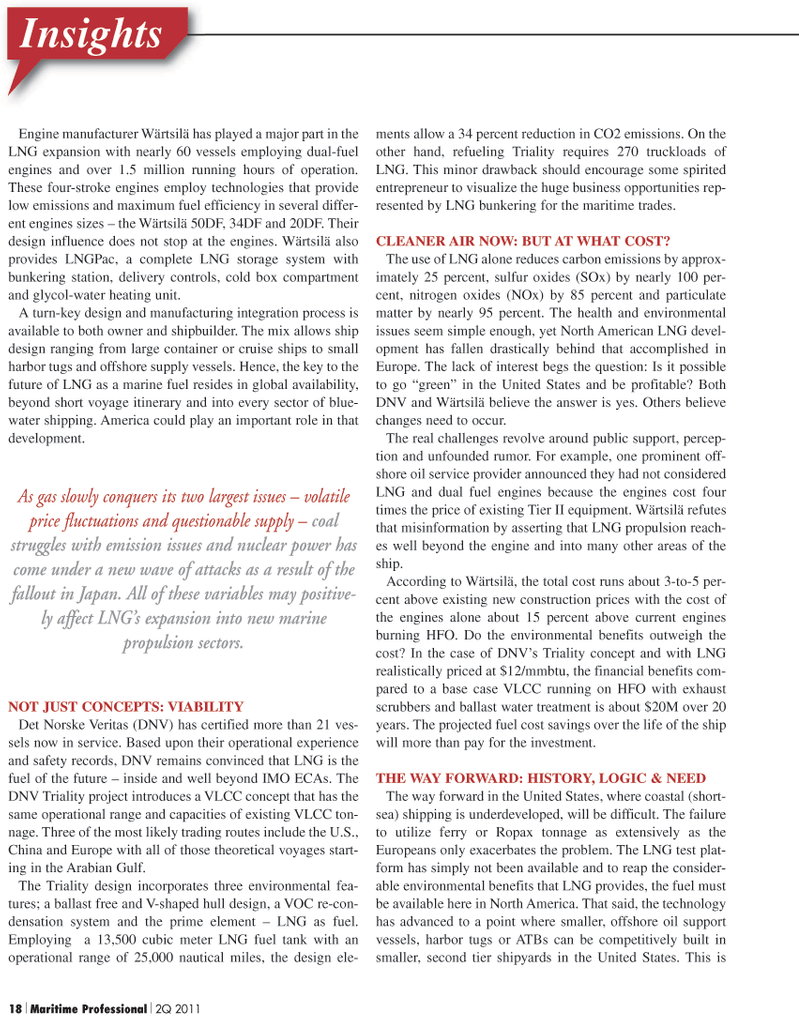
Page 18: of Maritime Logistics Professional Magazine (Q2 2011)
Energy Transportation
Read this page in Pdf, Flash or Html5 edition of Q2 2011 Maritime Logistics Professional Magazine
18 Maritime Professional 2Q 2011
Engine manufacturer Wärtsilä has played a major part in the
LNG expansion with nearly 60 vessels employing dual-fuel engines and over 1.5 million running hours of operation.
These four-stroke engines employ technologies that provide low emissions and maximum fuel efficiency in several differ- ent engines sizes – the Wärtsilä 50DF, 34DF and 20DF. Their design influence does not stop at the engines. Wärtsilä also provides LNGPac, a complete LNG storage system with bunkering station, delivery controls, cold box compartment and glycol-water heating unit.
A turn-key design and manufacturing integration process is available to both owner and shipbuilder. The mix allows ship design ranging from large container or cruise ships to small harbor tugs and offshore supply vessels. Hence, the key to the future of LNG as a marine fuel resides in global availability, beyond short voyage itinerary and into every sector of blue- water shipping. America could play an important role in that development.
NOT JUST CONCEPTS: VIABILITY
Det Norske Veritas (DNV) has certified more than 21 ves- sels now in service. Based upon their operational experience and safety records, DNV remains convinced that LNG is the fuel of the future – inside and well beyond IMO ECAs. The
DNV Triality project introduces a VLCC concept that has the same operational range and capacities of existing VLCC ton- nage. Three of the most likely trading routes include the U.S.,
China and Europe with all of those theoretical voyages start- ing in the Arabian Gulf.
The Triality design incorporates three environmental fea- tures; a ballast free and V-shaped hull design, a VOC re-con- densation system and the prime element – LNG as fuel.
Employing a 13,500 cubic meter LNG fuel tank with an operational range of 25,000 nautical miles, the design ele- ments allow a 34 percent reduction in CO2 emissions. On the other hand, refueling Triality requires 270 truckloads of
LNG. This minor drawback should encourage some spirited entrepreneur to visualize the huge business opportunities rep- resented by LNG bunkering for the maritime trades.
CLEANER AIR NOW: BUT AT WHAT COST?
The use of LNG alone reduces carbon emissions by approx- imately 25 percent, sulfur oxides (SOx) by nearly 100 per- cent, nitrogen oxides (NOx) by 85 percent and particulate matter by nearly 95 percent. The health and environmental issues seem simple enough, yet North American LNG devel- opment has fallen drastically behind that accomplished in
Europe. The lack of interest begs the question: Is it possible to go “green” in the United States and be profitable? Both
DNV and Wärtsilä believe the answer is yes. Others believe changes need to occur.
The real challenges revolve around public support, percep- tion and unfounded rumor. For example, one prominent off- shore oil service provider announced they had not considered
LNG and dual fuel engines because the engines cost four times the price of existing Tier II equipment. Wärtsilä refutes that misinformation by asserting that LNG propulsion reach- es well beyond the engine and into many other areas of the ship.
According to Wärtsilä, the total cost runs about 3-to-5 per- cent above existing new construction prices with the cost of the engines alone about 15 percent above current engines burning HFO. Do the environmental benefits outweigh the cost? In the case of DNV’s Triality concept and with LNG realistically priced at $12/mmbtu, the financial benefits com- pared to a base case VLCC running on HFO with exhaust scrubbers and ballast water treatment is about $20M over 20 years. The projected fuel cost savings over the life of the ship will more than pay for the investment.
THE WAY FORWARD: HISTORY, LOGIC & NEED
The way forward in the United States, where coastal (short- sea) shipping is underdeveloped, will be difficult. The failure to utilize ferry or Ropax tonnage as extensively as the
Europeans only exacerbates the problem. The LNG test plat- form has simply not been available and to reap the consider- able environmental benefits that LNG provides, the fuel must be available here in North America. That said, the technology has advanced to a point where smaller, offshore oil support vessels, harbor tugs or ATBs can be competitively built in smaller, second tier shipyards in the United States. This is
Insights
As gas slowly conquers its two largest issues – volatile price fluctuations and questionable supply – coal struggles with emission issues and nuclear power has come under a new wave of attacks as a result of the fallout in Japan. All of these variables may positive- ly affect LNG’s expansion into new marine propulsion sectors.

 17
17

 19
19
